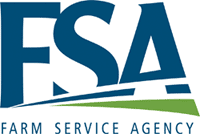WASHINGTON, April 26, 2012— USDA Farm Service Agency (FSA) Administrator Bruce Nelson today announced that USDA’s Commodity Credit Corporation (CCC) and the state of Arkansas entered into a revised agreement to add additional incentives to the Conservation Reserve Enhancement Program (CREP). The Illinois River Watershed CREP, as it is more commonly known, was created to reduce nutrient, bacterial and sediment load in the Illinois River Watersheds.
“USDA is proud to work with the state of Arkansas to enroll up to 10,000 acres of eligible cropland and marginal pastureland to enhance the water quality, biological diversity and aquatic habitats of the Illinois River Watersheds,” said Nelson.
The agreement establishes riparian buffers and filter strips on marginal pastureland and cropland with a goal of reducing 85,000 tons of annual sediment loading into local streams and waterways.
Farmers and ranchers will be able to apply for this program at their Farm Service Agency (FSA) Service Centers. FSA will administer the Illinois River Watershed CREP on behalf of CCC, working with USDA’s Natural Resources Conservation Service (NRCS), the state of Arkansas’ Natural Resources Commission (ANRC), and with other state CREP partners.
The primary objectives of this agreement are to conserve, restore and protect water quality and other natural resources within the targeted area through the installation and maintenance of riparian buffers. The program will provide producers financial and technical assistance to protect water resources and curb development by entering into permanent or long-term easement agreements.
Revisions to the Agreement
Under the addendum to the Illinois River Watershed CREP in Arkansas, the following additional provisions were made:
Enrollment revised to 10,000 acres. Riparian buffers (Cropland and Marginal Pastureland) , CP-22 – up to 6,700 acres and Marginal Pastureland Wildlife Habitat Buffers, CP-29 – up to 3,300 acres. Maximum average buffer widths may include areas exceeding 300 feet, if overland out-of-bank flow shows evidence of scour erosion, sediment deposition or debris deposits. Federal incentive payments are increased to 100 percent of base cropland soil rental rate or marginal pastureland rental rate. The state will make a one-time, lump-sum payment of $400 per acre on the first 1,000 acres enrolled in the Illinois River Watershed CREP. After the first 1,000 acres are enrolled, the state will make a one-time, lump-sum payment of $200 per acre for acres enrolled in the Illinois River Watershed CREP.
The CCC will pay up to 50 percent of the cost of installing conservation practices. CCC will also pay a 40 percent one-time Practice Incentive Payment of the total eligible cost of practice installation. Conservation practices for the Illinois River Watershed CREP are specialized to meet Arkansas’ unique natural resource conditions, and CREP goals. Federal annual rental payments are provided based on the cropland or marginal pastureland rental rates. Additionally, a CCC signing incentive payment equal to $100 per acre for 10 years will be paid.
The state of Arkansas will provide a one-time total of $400 per acre signing incentive payment on the first 1,000 acres enrolled in the Illinois River Watershed CREP project. After the first 1,000 acres have been enrolled, the state of Arkansas will provide a one-time $200 per acre signing incentive payment for participation in the CREP project. The state will allow eligible participants to utilize a riparian and wetland restoration state tax credit for out-of-pocket costs incurred as part of the CREP practice installation. CREP participants also will be provided, on a voluntary basis, an opportunity to enroll federal contract acres in a state permanent or long-term easement.
The total cost of the Illinois River Watershed CREP Program Agreement over the life of the project is estimated at $21.1 million for a total enrollment of 10,000 acres. The state of Arkansas will contribute $5.7 million to support the overall program cost.
For more information about Farm Service Agency (FSA) conservation programs visit www.fsa.usda.gov.






